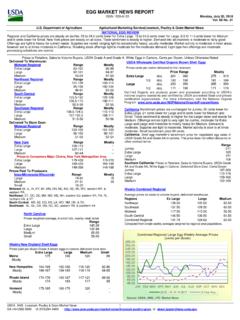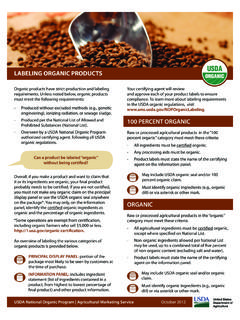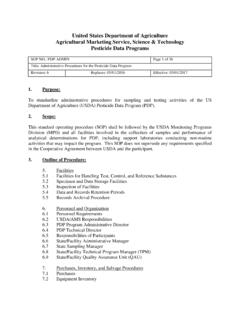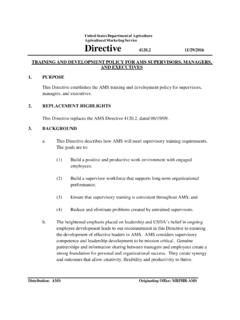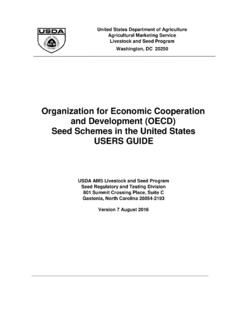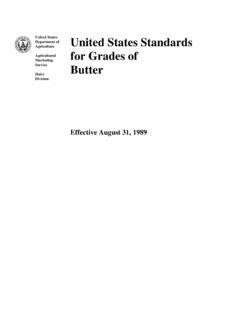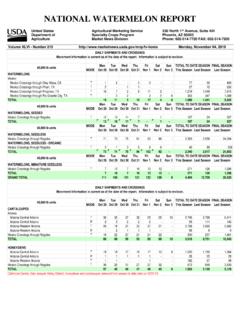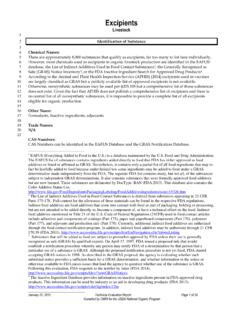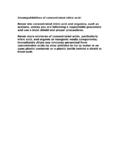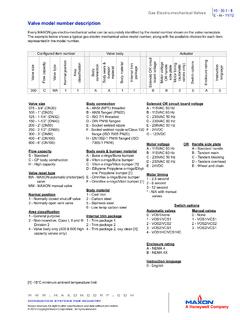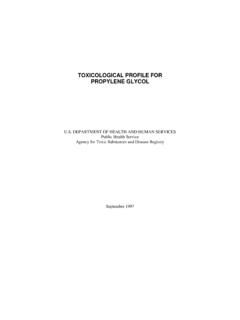Transcription of Propylene Glycol - Technical Report - 2021
1 Propylene Glycol Livestock _____ March 5, 2021 Technical Evaluation Report Page 1 of 25 Compiled by Nexight Group for the USDA National Organic Program Identification of Petitioned Substance 1 2 Chemical Names: 3 1,2-propanediol 4 Propane-1,2-diol 5 1,2- Propylene Glycol 6 1,2-dihydroxypropane 7 2- Hydroxypropanol 8 9 Other Name: 10 Propylene Glycol 11 Methylethyl Glycol 12 Methylethylene Glycol 13 Isopropylene Glycol 14 Monopropylene Glycol 15 16 Trade Names: 17 Keto Plus Gel; Dairy & Beef Nutri-Drench; Propylene Glycol USP ; Propylene Advantage Energy Supplement CAS Numbers: 57-55-6 Other Codes: EPA Pesticide Chemical Code: 068603 EINECS: 200-338-0 InChi Key: DNIAPMSPPWPWGF-UHFFFAOYSA-N 18 Summary of Petitioned Use 19 20 Propylene Glycol is currently allowed for use under the National Organic Program (NOP) regulations at 7 21 CFR (a)(27) as a synthetic material only for the treatment of ketosis in ruminants.
2 This Report serves 22 to provide Technical information to complement the 2002 Technical Advisory Panel Report on Propylene 23 Glycol for the National Organic Standards Board (NOSB) s sunset review. 24 25 26 Characterization of Petitioned Substance 27 28 Composition of the Substance: 29 Propylene Glycol , also called 1,2-propanediol, is a three-carbon diol (Sullivan, 1993). Its status as a diol (a 30 molecule with two hydroxyl groups [- OH groups]) leads to its many uses as a polar material with a high boiling 31 point ( Sullivan, 1993; West et al., 2014). Propylene Glycol is commercially available as a racemic mixture, meaning 32 that it includes both the left- and right-handed versions of the molecule (isomers) (Sullivan, 1993; West et al.)
3 , 33 2014). The two hydroxyls are located on carbons 1 and 2 (Fig. 1). 34 35 Figure 1. Chemical structure of Propylene Glycol (ChemIDplus, 2021) 36 37 38 39 Source or Origin of the Substance: 40 Propylene Glycol is commercially produced through the hydrolysis of Propylene oxide (Sullivan, 1993; 41 Zhang et al., 2001). The original source of the Propylene oxide is typically Propylene , generated either 42 through the steam cracking of hydrocarbons or through the dehydrogenation of propane, both of which are 43 non-renewable sources (Barnicki, 2012; Saxena et al., 2010). 44 45 Technical Evaluation Report Propylene Glycol Livestock March 5, 2021 Page 2 of 25 Researchers and manufacturers are improving methods to produce Propylene Glycol on a commercially 46 viable scale via two additional routes: 47 Catalytic hydrogenolysis of glycerol, a method that is becoming more economically feasible with 48 the increased production of glycerol through biomass-produced ethanol (Berlowska et al.
4 , 2016; 49 Chiu et al. 2008; Marchesan et al., 2019) 50 Microbial fermentation through a number of different microorganisms (Marchesan et al., 2019; 51 Veeravalli & Matthews, 2019) 52 53 See Evaluation Question #2 for details regarding these specific manufacturing processes. 54 55 Properties of the Substance: 56 Propylene Glycol is a colorless, viscous liquid that is nearly odorless but faintly sweet in flavor. Table 1 57 summarizes the chemical and physical properties of Propylene Glycol . 58 59 Table 1. Chemical and Physical Properties of Propylene Glycol 60 Property Description or Value Physical state at 20 C Liquid Color Colorless Odor Nearly odorless Molecular formula C3H8O2 Molecular weight (g/mol) Density (g/cm3) at 20 C Dynamic viscosity (mPa s) at 20 C 56 Vapor pressure (kPa) at 20 C Melting point ( C) -60 Boiling point ( C) Specific heat capacity (kJ kg-1 K-1) at 20 C Heat conductivity (Wm-1 K-1) at 20 C Henry s Law Constant (atm m3/mol) at 25 C 10-8 Log Kow Log Koc Data source: Sullivan (1993); US PubChem (2020); West et al.
5 (2014) 61 62 Specific Uses of the Substance: 63 Propylene Glycol has a wide range of uses, including as a chemical precursor to industrial production, as an 64 ingredient in cosmetics, and as a disinfectant (Sullivan, 1993; West et al., 2014). This Technical Report focuses 65 on its use in livestock health care for the treatment of ketosis in ruminants. This section also contains a brief 66 description of the use of Propylene Glycol as an excipient ingredient in livestock health care inputs as well 67 as uses beyond livestock care. 68 69 Ketosis 70 The allowed use of Propylene Glycol in organic production is only as a treatment for ketosis in ruminants 71 (21 CFR (a)(27)).
6 Propylene Glycol is typically administered in an oral drench to animals showing 72 signs of clinical ketosis or to animals that a producer suspects of having subclinical ketosis. Clinical ketosis 73 includes symptoms such as loss of appetite, loss of body condition, a decrease in milk production, and 74 increased levels of ketone bodies in blood (Baird, 1982; Nielsen & Ingvartsen, 2004). Subclinical ketosis 75 exhibits through an excess of ketone bodies in an animal s blood, urine, and milk without the other 76 observable signs of clinical ketosis (Duffield, 2000; McArt et al., 2012; Nielsen & Ingvartsen, 2004). Testing 77 is often required to confirm subclinical ketosis.
7 Both clinical and subclinical ketosis are also characterized 78 by decreased level of blood glucose and increased levels of non-esterified fatty acids (NEFA) (Herdt, 2000; 79 Nielsen & Ingvartsen, 2004). 80 81 Ketosis is a metabolic disease that can result from energy imbalance in early lactation. The majority of a 82 dose of Propylene Glycol is not fermented in the rumen. I nstead, it is directly absorbed and metabolized by 83 Technical Evaluation Report Propylene Glycol Livestock March 5, 2021 Page 3 of 25 the liver to form glucose ( Emery et al., 1967; Grummer et al., 1994; Nielsen & Ingvartsen, 2004). The glucose 84 aids when liver function is impaired soon after parturition (labor and delivery) ( Grummer et al.)
8 , 1994; 85 Johnson, 1954; McArt et al., 2012). The metabolized glucose also serves as an energy supplement when 86 nutritional demand outstrips dry matter intake later in the lactation period (Herdt, 2000). The proper dose 87 of Propylene Glycol can aid in the recovery from both clinical and subclinical ketosis by stabilizing an 88 animal s blood glucose level (Johnson, 1954; Grummer et al., 1994; Herdt, 2000; McArt et al., 2012). 89 90 Other Uses 91 Propylene Glycol is generally recognized as safe (GRAS) by the FDA (21 CFR ) and is a 92 common ingredient in several topical health care materials as an excipient ingredient. Propylene Glycol is 93 also a common ingredient in products such as lotions, balms, and salves due to its ability to retain moisture 94 ( , Udder Comfort ; UltraCruz Udder Balm ; KenAg Udder Cream).
9 95 96 Beyond livestock health care uses, Propylene Glycol is widely used in a number of manufacturing and food 97 production roles. In food processing, Propylene Glycol serves as a humectant and a preservative (Barnicki, 98 2012; Hasenhuettl & Hartel, 2019). Propylene Glycol is also used as a carrier in e-cigarette liquids (Scheffler 99 et al., 2015) and is a common polyester resin in the manufacturing of automotive plastics and fiberglass as 100 well as construction materials. Due to its low toxicity (especially relative to ethylene Glycol ) and high 101 biodegradability, Propylene Glycol is commonly used as an aircraft deicer and as an automotive antifreeze 102 solution (Bielefeldt et al.)
10 , 2002; Klecka et al., 1993; Sullivan, 1993). 103 104 Approved Legal Uses of the Substance: 105 Food and Drug Administration (FDA) 106 Under FDA regulations, Propylene Glycol is allowed in animal drugs, feeds, and related products, with the 107 exception of cat food (21 CFR ). The FDA first approved Propylene Glycol as GRAS for a broad 108 range of direct food additive uses in 1982 (FDA, 2020). Propylene Glycol is allowed in food in a wide 109 variety of functions, including as an anticaking agent, an emulsifier, a flavor agent, a humectant, and as a 110 texturizer. The FDA has also approved Propylene Glycol as an indirect food additive at 21 CFR 175, 111 including uses in resinous and polymeric coatings, components in paperboard, rubber articles intended for 112 repeated uses, and textile fabrics.
